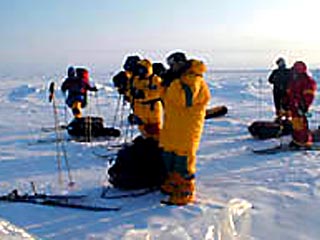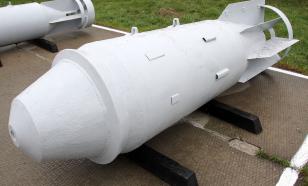New theory of early human migration patterns
 Russian scientists discovered ancient mammoth site right past the polar circle (at 66 degree latitude).
Russian scientists discovered ancient mammoth site right past the polar circle (at 66 degree latitude).

The find proves the fact that humans inhabited the territory past the polar circle much earlier than was originally thought. According to their hypothesis, Eurasia could not have been first inhabited not from the abundant Southern lands (as modern science assumes) but from the harsh North instead.
They consider that at some point, Northern climate used to be warm and living conditions were remarkably beneficial. Society blossomed, people did not hunger; there were no diseases, no wars. But then something happened, some cataclysm occurred and our ancestors were forced to leave northlands.
Today, two versions prevail: one is strictly academic, based on archaeological data and an alternative one, based mainly on various hypotheses, writes Russian journal “Itogi”.
Those who support the first academic version believe in the fact that first humans came to high latitudes from South. “Alternativtsts,” on the contrary, believe in the existence of a legendary country “Hyperborea”, people of which had to migrate to southern territories due to sudden climate change.
Basically, the main question is that whether our ancestors migrated northward or vice versa, moved from North to South. It seems, that Russian scientists managed to acquire evidences proving the fact that harsh Arctic climate were inhabited by humans much earlier than was originally thought. This in turn proves the possibility of further migration pattern southward.
The site is located in the republic of Komi, on the banks of the river Usy, right past the polar circle. Joint Russian-Norwegian archaeological expedition has been working on the site for several years.
One of the leaders of the expedition, senior staff scientist of the language and history Institute of the Republic of Komi Pavel Pavlov stated the following: “In the course of the digs at the place called Mammoth Kurye, we’ve unearthed more than a hundred bones of various animals: northern deer, horses, wolfs. One of the bones has an arrow-head stuck in it. However, the most fascinating discovery of a mammoth’s tusk with a clear drawing depicting several deep incisions made by two different types of instruments.”
“Radiocarbon dating method revealed that the tusk is nearly 40 000 years old and that the incisions have been made by means of two sharp stone objects. Interestingly, even the types of stones appear to be different. No one else could do this aside from human. The bone quality and that of stone objects suggest high level of development of those ancient people of the polar region,” added the scientist.
One of the founders of the International scientific-research movement, head of the expedition “Hyperborea” professor Valeri Demin has no doubts that North is the cradle of humanity.
Official science however never took the “polar concept” seriously. The so-called “glacial theory” is the most widely accepted. According to it, 20-15 000 years ago north of Eurasia all through Carpathians was fully covered with thick ice; life was simply non existent in the region.
Subscribe to Pravda.Ru Telegram channel, Facebook, RSS!




